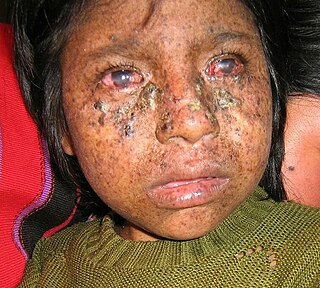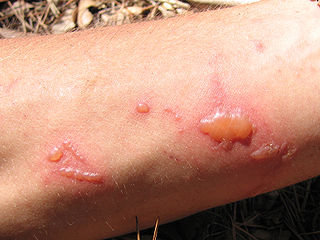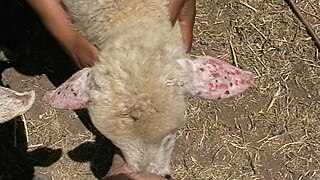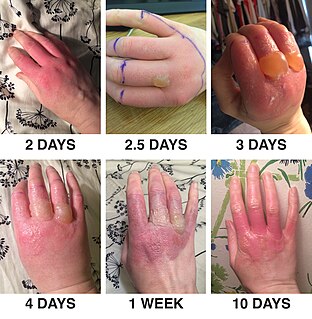Photosensitivity is the amount to which an object reacts upon receiving photons, especially visible light. In medicine, the term is principally used for abnormal reactions of the skin, and two types are distinguished, photoallergy and phototoxicity. [1] [2] The photosensitive ganglion cells in the mammalian eye are a separate class of light-detecting cells from the photoreceptor cells that function in vision.
Sensitivity of the skin to a light source can take various forms. People with particular skin types are more sensitive to sunburn. Particular medications make the skin more sensitive to sunlight; these include most of the tetracycline antibiotics, heart drugs amiodarone, and sulfonamides. Some dietary supplements, such as St. John's Wort, include photosensitivity as a possible side effect.
Particular conditions lead to increased light sensitivity. Patients with systemic lupus erythematosus experience skin symptoms after sunlight exposure; some types of porphyria are aggravated by sunlight. A rare hereditary condition xeroderma pigmentosum (a defect in DNA repair) is thought to increase the risk of UV-light-exposure-related cancer by increasing photosensitivity.
Photosensitivity occurs in multiple species including sheep, bovine, and horses. They are classified as primary if an ingested plant contains a photosensitive substance, like hypericin in St John's wort poisoning and ingestion of biserrula (Biserrula pelecinus) [3] in sheep, or buckwheat plants (green or dried) in horses. [4]
In hepatogenous photosensitization, the photosensitzing substance is phylloerythrin, a normal end-product of chlorophyll metabolism. [5] It accumulates in the body because of liver damage, reacts with UV light on the skin, and leads to free radical formation. These free radicals damage the skin, leading to ulceration, necrosis, and sloughing. Non-pigmented skin is most commonly affected.

Ultraviolet (UV) is a form of electromagnetic radiation with wavelength from 10 nm to 400 nm (750 THz), shorter than that of visible light, but longer than X-rays. UV radiation is present in sunlight, and constitutes about 10% of the total electromagnetic radiation output from the Sun. It is also produced by electric arcs and specialized lights, such as mercury-vapor lamps, tanning lamps, and black lights. Although long-wavelength ultraviolet is not considered an ionizing radiation because its photons lack the energy to ionize atoms, it can cause chemical reactions and causes many substances to glow or fluoresce. Consequently, the chemical and biological effects of UV are greater than simple heating effects, and many practical applications of UV radiation derive from its interactions with organic molecules.

Photodynamic therapy (PDT) is a form of phototherapy involving light and a photosensitizing chemical substance, used in conjunction with molecular oxygen to elicit cell death (phototoxicity).

Photodermatitis, sometimes referred to as sun poisoning or photoallergy, is a form of allergic contact dermatitis in which the allergen must be activated by light to sensitize the allergic response, and to cause a rash or other systemic effects on subsequent exposure. The second and subsequent exposures produce photoallergic skin conditions which are often eczematous. It is distinct from sunburn.

Xeroderma pigmentosum (XP) is a genetic disorder in which there is a decreased ability to repair DNA damage such as that caused by ultraviolet (UV) light. Symptoms may include a severe sunburn after only a few minutes in the sun, freckling in sun exposed areas, dry skin and changes in skin pigmentation. Nervous system problems, such as hearing loss, poor coordination, loss of intellectual function and seizures, may also occur. Complications include a high risk of skin cancer, with about half having skin cancer by age 10 without preventive efforts, and cataracts. There may be a higher risk of other cancers such as brain cancers.

Sunless tanning, also known as UV filled tanning, self tanning, spray tanning, or fake tanning, refers to the effect of a suntan without the Sun. Sunless tanning involves the use of oral agents (carotenids), or creams, lotions or sprays applied to the skin. Skin-applied products may be skin-reactive agents or temporary bronzers (colorants).
PUVA is an ultraviolet light therapy treatment for skin diseases: eczema, psoriasis, graft-versus-host disease, vitiligo, mycosis fungoides, large plaque parapsoriasis, and cutaneous T-cell lymphoma, using the sensitizing effects of the drug psoralen. The psoralen is applied or taken orally to sensitize the skin, then the skin is exposed to UVA.
Light sensitivity or photosensitivity refers to a notable or increased reactivity to light. Apart from vision, human beings have many physiological and psychological responses to light. In rare individuals an atypical response may result in serious discomfort, disease, or injury. Some drugs have a photosensitizing effect. Properties of natural or artificial light that may abnormally affect people include:

Phototoxicity, also called photoirritation, is a chemically induced skin irritation, requiring light, that does not involve the immune system. It is a type of photosensitivity.

Photosensitizers produce a physicochemical change in a neighboring molecule by either donating an electron to the substrate or by abstracting a hydrogen atom from the substrate. At the end of this process, the photosensitizer eventually returns to its ground state, where it remains chemically intact until the photosensitizer absorbs more light. This means that the photosensitizer remains unchanged before and after the energetic exchange, much like heterogeneous photocatalysis. One branch of chemistry which frequently utilizes photosensitizers is polymer chemistry, using photosensitizers in reactions such as photopolymerization, photocrosslinking, and photodegradation. Photosensitizers are also used to generate prolonged excited electronic states in organic molecules with uses in photocatalysis, photon upconversion and photodynamic therapy. Generally, photosensitizers absorb electromagnetic radiation consisting of infrared radiation, visible light radiation, and ultraviolet radiation and transfer absorbed energy into neighboring molecules. This absorption of light is made possible by photosensitizers' large de-localized π-systems, which lowers the energy of HOMO and LUMO orbitals to promote photoexcitation. While many photosensitizers are organic or organometallic compounds, there are also examples of using semiconductor quantum dots as photosensitizers.

Polymorphous light eruption (PLE), sometimes also called polymorphic light eruption (PMLE), is a non-life-threatening and potentially distressing skin condition that is triggered by sunlight and artificial UV exposure in a genetically susceptible person, particularly in temperate climates during the spring and early summer. Due to its many clinical appearances, it is named polymorphic or polymorphous and the terms are used interchangeably. The resulting itch can cause significant suffering.

Photosensitivity is an abnormal skin reaction to direct sunlight exposure. It is unrelated to a sunburn. These reactions are due to photosensitization, the accumulation of photosensitive compounds beneath the skin. In some cases, the photodynamic substances come from ingested plants or drugs, after being metabolized or not. In other cases, the photodynamic substances may be produced in the body itself due to inborn errors in pigment metabolism, especially those involving the heme synthesis. Photosensitivity reactions are usually seen in herbivorous or omnivorous animals, though such reactions are known among carnivores.
Photomedicine is an interdisciplinary branch of medicine that involves the study and application of light with respect to health and disease. Photomedicine may be related to the practice of various fields of medicine including dermatology, surgery, interventional radiology, optical diagnostics, cardiology, circadian rhythm sleep disorders and oncology.
Phototoxins are toxins that can cause allergic reactions in particularly susceptible individuals and which can cause dangerous photosensitivity in a much broader range of subjects.

Solar urticaria (SU) is a rare condition in which exposure to ultraviolet or UV radiation, or sometimes even visible light, induces a case of urticaria or hives that can appear in both covered and uncovered areas of the skin. It is classified as a type of physical urticaria. The classification of disease types is somewhat controversial. One classification system distinguished various types of SU based on the wavelength of the radiation that causes the breakout; another classification system is based on the type of allergen that initiates a breakout.

Phytophotodermatitis, also known as berloque dermatitis or margarita photodermatitis, is a cutaneous phototoxic inflammatory reaction resulting from contact with a light-sensitizing botanical agent followed by exposure to ultraviolet light. Symptoms include erythema, edema, blisters, and delayed hyperpigmentation. Heat and moisture tend to exacerbate the reaction.
Chronic actinic dermatitis is a condition where a subject's skin becomes inflamed due to a reaction to sunlight or artificial light. Patients often have other related conditions of the skin that cause dermatitis in response to a variety of stimuli.
Actinic prurigo is a rare sunlight-induced, pruritic, papular or nodular skin eruption. Some medical experts use the term actinic prurigo to denote a rare photodermatosis that develops in childhood and is chronic and persistent; this rare photodermatosis, associated with the human leukocyte antigen HLA-DR4, is often called "Familial polymorphous light eruption of American Indians" or "Hereditary polymorphous light eruption of American Indians" but some experts consider it to be a variant of the syndrome known as polymorphous light eruption (PMLE). Some experts use the term actinic prurigo for Hutchinson's summer prurigo and several other photodermatoses that might, or might not, be distinct clinical entities.

Sunburn is a form of radiation burn that affects living tissue, such as skin, that results from an overexposure to ultraviolet (UV) radiation, usually from the Sun. Common symptoms in humans and animals include: red or reddish skin that is hot to the touch or painful, general fatigue, and mild dizziness. Other symptoms include blistering, peeling skin, swelling, itching, and nausea. Excessive UV radiation is the leading cause of (primarily) non-malignant skin tumors, and in extreme cases can be life-threatening. Sunburn is an inflammatory response in the tissue triggered by direct DNA damage by UV radiation. When the cells' DNA is overly damaged by UV radiation, type I cell-death is triggered and the tissue is replaced.

Fluorescent lamps have been suggested to affect human health in various ways.
Heliophobia refers to light sensitivity: